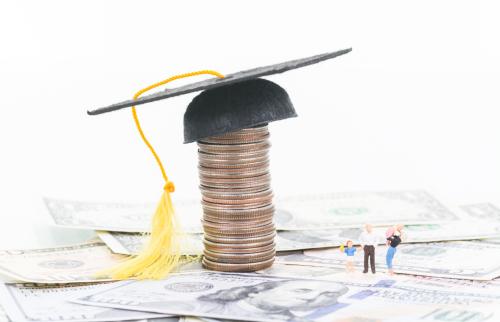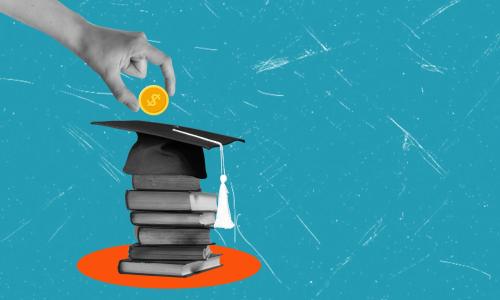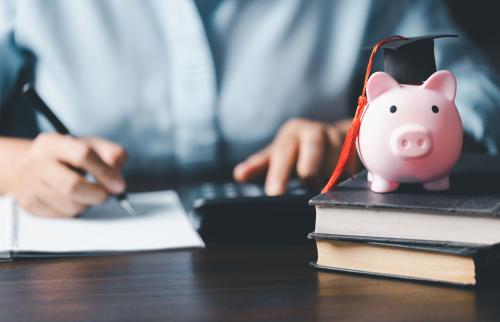Introduction
The 2025 reconciliation bill (the One Big Beautiful Bill Act, OBBBA) signed into law this summer will change how new student loan borrowers repay their loans, especially for those who participate in Income Driven Repayment (IDR) plans. The bill introduced a new IDR plan called the Repayment Assistance Plan (RAP), which will replace all existing IDR plans for new borrowers.
Scheduled to open for enrollment next July, RAP will make several changes relative to earlier IDR plans. The formula for determining the monthly payment will be different: RAP will require a minimum monthly payment of $10 and will incorporate a “principal subsidy,” which guarantees outstanding balances decline at least a little each month for borrowers who make on-time payments. Under IDR plans, when payments based on income are not enough to bring a borrower’s balance to zero after a set amount of time, the remaining balance is forgiven. Notably, the time to forgiveness in RAP will be 30 years, compared to 10 to 25 years in the earlier IDR plans that will not be available to new borrowers.
This increase in time to forgiveness under RAP will be most significant for undergraduate borrowers who take out relatively small loans. That is because under earlier IDR plans, such borrowers could have their balances forgiven in as few as 10 years. The idea that the time to forgiveness should be shorter for borrowers with smaller balances has enjoyed bipartisan support. For example, in the Lowering Education Costs and Debt Act, Senate Republicans proposed a 10-year forgiveness timeline for borrowers with initial balances of less than $10,000, with each additional $1,000 of balance extending the time to forgiveness by 1 year, up to 19 years.
This idea was incorporated into a new IDR plan introduced during the Biden administration, Saving on a Valuable Education (SAVE). While earlier IDR plans generally required borrowers to make payments for 20 to 25 years, under SAVE, undergraduate borrowers with original balances of less than $12,000 receive forgiveness after just 10 years. Each additional $1,000 of initial balance over $12,000 increases the time to forgiveness by 1 year, up to 20 years. SAVE opened for enrollment in August 2023 but has been blocked by the courts since July 2024. Some borrowers did receive forgiveness under the new low-balance undergraduate borrower provision before the court stepped in.
RAP will not include a shorter time to forgiveness for low-balance borrowers, even though the default forgiveness timeline was increased to 30 years.
In this report, we discuss the potential value and costs of adding a provision to shorten the forgiveness timeline for low-balance undergraduate borrowers to the RAP plan. Such a provision would be low-cost and well-targeted, benefiting low-income borrowers who are most in need of help. Although direct evidence on the effects of a shorter time to forgiveness for low-balance borrowers is not available, such a provision could help improve college access, while encouraging students to limit the amount they borrow. More analysis of the distributional effects and costs is needed to better quantify these trade-offs, but Congress should consider incorporating this provision in RAP.
What problem does a shorter time to forgiveness for low-balance borrowers solve?
Many student loan borrowers with small loan balances also have low income, which makes it difficult for them to make progress paying down even their relatively small loans. Forcing these borrowers to remain in repayment for up to 30 years is arguably punitive, imposing financial, administrative, and psychological costs that are likely large relative to the amount of money involved. The shortened time to forgiveness for low-balance undergraduate borrowers in SAVE (and proposed in the Lowering Education Costs and Debt Act) addresses the needs of this group.
On average, student loan borrowers with lower balances are more likely to struggle with repayment, compared to borrowers with higher balances.1 For example, an analysis of borrowers who left school in 2009 found that 34 percent of those who borrowed less than $5,000 defaulted by 2014, compared to just 18 percent of those who borrowed more than $100,000. High balances are typical for many borrowers who earned a graduate or professional degree; for example, the median cumulative debt for law and medical school graduates in 2023 was about $117,000 and $230,000, respectively. These advanced degrees often lead to high earnings, allowing borrowers to pay off their large loans. On the other hand, many low-balance borrowers attended some college without completing a degree. As a result, their earnings are often low, and they struggle to pay off their student loans, despite borrowing a modest amount.
Many discussions about the difficulties faced by this “some college, no degree” group focus on improving completion rates by addressing barriers that prevent students from graduating. Indeed, there has been modest improvement in average college completion rates in recent years, though rates for particular programs and institutions vary widely. Other important efforts, including other provisions of the reconciliation bill, seek to reduce the likelihood that students borrow to enroll in programs with low returns on their investment.
While reducing the number of students who invest their time and money in college without graduating is a worthwhile policy goal, some borrowers will inevitably end up dropping out before completing a degree. Indeed, even the most effective college success programs leave roughly half of students without a degree. Moreover, it may not be optimal for all students who start college to complete their degree. Some students who start college may learn something about how their chosen program matches their interests and abilities or their circumstances may change such that it does not make sense to complete their program. But this does not mean that it was a mistake to enroll in the first place: High school graduates have limited information and attending college is sometimes the only way to learn whether it is a good match. That is, enrolling in college has “option value.”
If the downside risk of borrowing to attend college feels too high, students from low-income backgrounds might choose not to try. Indeed, providing insurance to protect borrowers from financial distress in case their education does not pay off as expected is one of the key purposes of IDR policy. The possibility that debt could follow them for up to 30 years, even if the payment depends on income, may make debt averse individuals take a pass on higher education.
Shortening the timeline is well-targeted and cost-efficient
A shortened forgiveness timeline for low-balance undergraduate borrowers would provide well-targeted benefits to low-income borrowers at a modest cost.
This provision is effectively targeted due to a key difference between IDR plans and the standard plan: Borrowers with lower incomes make smaller monthly payments under an IDR plan than borrowers with higher incomes, and borrowers with lower initial balances face smaller monthly payments under a standard plan than borrowers with higher balances. This means that to benefit from RAP (or any previous IDR plan), a borrower’s income must be low enough that their monthly payment under RAP is less than their monthly payment under the standard plan.2 Moreover, in cases where high-income borrowers with low balances do choose to enroll in RAP, they would pay off their loan before reaching the time for forgiveness, even under a shorter timeline. Therefore, this provision can only help low-income borrowers with low balances.
For example, a single adult with no children who borrowed $5,000 would need to earn less than $30,000 to have a lower payment in RAP than in the standard plan. If they instead borrowed $15,000, the income threshold to benefit from RAP would be roughly $50,000.3
The cost of a shorter forgiveness timeline for low-balance borrowers would be relatively small. According to the Department of Education, the shorter forgiveness timeline under the SAVE rule would have cost an estimated $3.7 billion over ten years – less than 2.5 percent of the total estimated cost of SAVE. The cost of adding a similar provision to the RAP plan could be somewhat higher or lower, but in any case, would be modest relative to other policies that help students finance their higher education.4 For example, the Pell Grant program received $28.6 billion for fiscal year 2023 alone – nearly eight times the estimated cost of SAVE’s shorter forgiveness timeline over ten years. Consider also the PSLF program, which has an estimated 10-year cost of $28.3 billion. Indeed, the average balance forgiven under the PSLF program was over $70,000 in recent years. In contrast, under a shortened forgiveness timeline, only borrowers with low initial balances would qualify for earlier forgiveness. Furthermore, without this provision, many low-balance borrowers would only make small payments during their additional years in RAP. These payments may not be much more than the administrative costs of continuing to service these loans.
Since this provision would provide insurance against the risk that borrowers’ investments in higher education do not pay off, policymakers might worry about “moral hazard.” In other words, when borrowers – as well as institutions – face limited downside risk of borrowing, enrollment in low-quality programs and drop-out rates could increase. However, the shortened forgiveness timeline would provide only partial protection to borrowers and only to those who don’t borrow too much, so it is unlikely to exacerbate these potential unintended effects of IDR too much. Even with a shortened forgiveness timeline, students would still have “skin in the game.” Students pursuing higher education invest time and money beyond the amount that they borrow. And low-balance borrowers would still be making at least some payment monthly for many years, just fewer than 30.
Provision could address debt aversion, while limiting over-borrowing
For many students, borrowing a modest amount to attend college is a sound investment. Unfortunately, some students underinvest in higher education due to debt aversion, while others over-borrow. Getting this balance right is tricky, but a shorter forgiveness timeline could help.
Public opinion on post-secondary education has soured, heightening concerns about underinvestment in college. Although the politicization of higher education may raise concerns that lead some borrowers to underinvest, the legal battles over debt forgiveness and IDR policy during the Biden Administration have likely contributed to this trend as well. Many borrowers are left with the perception that pursuing college means saddling oneself with unmanageable debt.
While potential borrowers should carefully consider the costs and value of postsecondary education, debt aversion can make some young adults overly reluctant to pursue college. Students from low-income backgrounds may be particularly concerned about taking out loans; since they are less likely to have family assistance to fall back on if they struggle with repayment, they may be especially wary of the downside risks to their credit score, which could lead to higher interest rates for auto loans and greater barriers to homeownership. While evidence on how debt aversion affects educational choices is scant, by reducing the sense that student debt might follow a potential student for decades, a shortened forgiveness timeline could help lower-income students feel more comfortable borrowing reasonable amounts to make investments in higher education.
Encouraging modest borrowing could also improve key educational outcomes. Some evidence suggests that borrowing instead of working to pay for college could improve academic performance and completion rates.
On the other hand, some students may borrow too much. Indeed, when borrowers expect that at least some of their student loan balance will be forgiven, the marginal cost of borrowing more (to the borrower) is zero. This creates an incentive to over-borrow. A shorter forgiveness timeline for low-balance borrowers would blunt this adverse incentive.
Consider, for example, a $12,000 initial balance threshold for a 10-year forgiveness timeline (as in SAVE). If a student has already borrowed $12,000, taking on more debt would mean they need to spend more time in repayment before potentially receiving forgiveness.5 In other words, if it is communicated effectively to borrowers, this provision would incentivize students to limit the amount they borrow because they would bear some of the cost of borrowing beyond the low-balance threshold.
Ultimately, policymakers face a delicate balancing act: Encouraging students to be mindful when they borrow for education, without discouraging them from borrowing reasonable amounts to support valuable investments in their future. A shorter forgiveness timeline for low-balance borrowers is an additional tool policymakers can employ to help strike the right balance.
Multiple repayment timelines add complexity, but not too much
Student loan repayment options have been complex and confusing for borrowers and simplifying the system by reducing the number of repayment options to two is an important improvement. While introducing a shorter forgiveness timeline for low-balance borrowers would add some complexity to RAP, explaining this provision to borrowers—and potential borrowers—should be manageable.
Indeed, student loan policy has long incorporated different repayment horizons. Before SAVE was introduced, borrowers could choose between a standard plan (with fixed monthly payments to pay their full balance over 10 years), Graduated and Extended repayment plans with repayment horizons between 10 and 30 years, and four IDR plans with forgiveness timelines ranging from 10 to 25 years. Additionally, under the Public Service Loan Forgiveness (PSLF) program, borrowers who work in the government or non-profit sectors could receive forgiveness after just 10 years.
The reconciliation bill also introduced different repayment horizons to the standard repayment plan. While the standard plan previously had a uniform 10-year repayment timeline, in the new system, the repayment horizon on the standard plan depends on the initial balance and will range from 10 to 25 years. The longer horizon for larger balances acknowledges that more costly education investments (requiring more borrowing) often yield high returns, but those larger investments may take more time to pay off. This change to the standard plan establishes a relationship between original balances and time in repayment, an approach that could be extended to IDR plans (in this case, RAP).
The impact of a shorter horizon depends on other features of IDR, more analysis is needed
Shortening the timeline to forgiveness benefits borrowers by reducing the time they face the administrative and psychological costs, as well as default risk, associated with holding student debt. Whether and how much total payments decline with a shorter horizon depends on what borrowers’ payments would have been if their balance were not forgiven early. The government saves the cost of administering the loan but forgoes some payments. These trade-offs depend on other features of IDR plans, which affect the impact of this provision in complex ways.
Two changes in RAP relative to earlier IDR plans mean that many borrowers would be in repayment for a shorter period under RAP, relative to SAVE (or other earlier IDR plans), even without the shorter forgiveness timeline for low-balance borrowers. Namely, payments are generally higher in RAP than in SAVE, and RAP incorporates a “principal subsidy,” which means the balance is guaranteed to decline each month.6 Together, these differences mean that many borrowers will repay their balances earlier under RAP, thereby limiting the amount that would be forgiven through a shortened timeline for low-balance borrowers.
Consider, for example, a borrower with one child who took out $12,000 in student loans to attend college but did not complete her degree and earns $32,000 (increasing with inflation).7 Her income would be below the protected income threshold in SAVE, so she would owe $0 each month. Without the shortened forgiveness timeline, she would be in repayment for 20 years, the normal forgiveness timeline for borrowers who only have undergraduate debt.8 For this borrower, forgiving the loan in 10 years instead of 20 would save the government money (because the government must administer the loan but isn’t collecting any payments) and benefit the borrower.
The same hypothetical borrower would be in repayment for 17 years under RAP, rather than the full repayment period of 30 years. This is because she faces higher monthly payments than in SAVE (ranging from $30 to over $100 over the repayment period) and because she benefits from the principal subsidy for the first nine years of repayment.9 She would still benefit from a shortened forgiveness timeline, but earlier forgiveness would have different effects on borrowers and the government than it would under older IDR plans. A borrower with the same income and family composition with a starting balance of only $5,000 would be in repayment for about 10 years in the RAP plan, even without a provision shortening the time to forgiveness for low-balance borrowers.
These examples show how the principal subsidy in RAP (along with the higher required payments) can help achieve some of the same goals as the shortened forgiveness timeline for low-balance borrowers in SAVE.10 However, the shorter forgiveness timeline more explicitly targets a group that struggles with repayment —low balance borrowers with persistently low income —while the principal subsidy is less well-targeted to help the neediest borrowers. More analysis is needed to compare the distributional impacts and costs of the principal subsidy (as in RAP) and shorter forgiveness horizon (as in SAVE).
Conclusion
Adding a shortened forgiveness timeline for low-balance borrowers on IDR plans can be a well-targeted, low-cost policy to help ease the burden on student loan borrowers who borrow modest amounts and struggle with repayment, often because they did not complete college.
This provision might also help combat debt aversion without incentivizing over-borrowing, thereby encouraging students to make valuable investments in higher education. While the higher payments and principal subsidy in RAP mean that more borrowers will exit repayment sooner even without the shorter forgiveness timeline for low-balance borrowers, a shorter time to forgiveness is more straightforward to communicate. This provision could help potential borrowers feel comfortable borrowing modest amounts to try college, knowing the debt won’t follow them for up to 30 years.
Though this provision would introduce a modest amount of complexity to the student loan repayment system, there are already several different repayment horizons and precedents for multiple forgiveness timelines in IDR. Helping borrowers understand a shorter forgiveness timeline would be an important but manageable task.
SAVE provides a useful model for a shorter forgiveness timeline, but policymakers could adopt different parameters under RAP by varying the “low balance” threshold, the time to forgiveness, or both. These parameters should be clearly communicated to potential borrowers to ensure that they understand how the amount that they borrow will affect their repayment timeline.
The time to forgiveness interacts with other features of IDR, and under RAP, it would likely affect fewer borrowers than in SAVE. More analysis is needed to understand the distributional consequences and costs of a shorter forgiveness timeline for low-balance borrowers and its interaction with other features of IDR, but Congress should consider incorporating this provision into RAP.
-
Footnotes
- These findings reflect borrowers enrolled in both IDR and standard plans. Some low-balance borrowers struggle with repayment because they do not enroll in IDR plans for which they qualify, often due to administrative problems.
- Some borrowers may choose to enroll in RAP, despite facing higher monthly payments compared to the standard plan, if their income was lower in the past (or they expect it to be in the future) and they want to make qualifying payments towards Public Service Loan Forgiveness (PSLF) or IDR forgiveness.
- Calculations assume a 6 percent interest rate.
- It is difficult to predict how interactions with other RAP provisions would change the cost of the shortened forgiveness timeline, relative to its estimated cost under SAVE. For example, in the absence of a shortened forgiveness timeline, many low-balance borrowers may have continued to face very low (or even $0) monthly payments after 10 years under SAVE; these same borrowers may face somewhat higher monthly payments after 10 years under RAP. This would imply that the cost of forgone payments under a shortened forgiveness timeline would be higher under RAP. On the other hand, borrowers may have had a larger balance remaining at 10 years under SAVE, relative to RAP, implying that the cost of an early forgiveness timeline may be lower under RAP. Moreover, RAP may increase defaults, which could further lower the cost of a shortened forgiveness timeline, relative to SAVE.
- Whether the student would actually receive forgiveness would depend on their income.
- Under earlier IDR plans, the monthly payment is always applied to interest before principal; what happens when the payment is not enough to cover interest accruing the same month depends on the plan, but this means that loan balances often do not decline—and may increase as uncovered interest accumulates. Under RAP, the first $50 of each on-time monthly payment is applied to principal, then to interest, then to principal; and if the payment is not enough to cover the principal subsidy plus accrued interest, the uncovered interest is waived.
- Calculations assume a 3 percent inflation rate and a 6 percent interest rate.
- Under two earlier IDR plans – REPAYE and PAYE – she would have owed between $11-$19 each month while her child was under 18, far below the interest owed each month. This means that, despite making payments, she would not pay down her principle for 18 years. Therefore, under REPAYE and PAYE, she would also remain in repayment for the full 20-year period, despite borrowing a modest amount.
- Her monthly payments would be too low to cover interest during her first several years of repayment. This means that without the principal subsidy, her balance would not decline, and she would remain in repayment longer. Like SAVE, RAP also includes an implicit interest subsidy, which forgives borrowers’ accumulated interest when their monthly payment does not cover the interest they owe each month.
- Also, under current law, the amount of the principal subsidy is not adjusted for inflation. This means that the real value of the principal subsidy will fall over time. (The payment rate brackets are also not adjusted for inflation, so real payments for low-income borrowers will become increasingly unaffordable as well as nominal incomes rise with inflation.)
The Brookings Institution is committed to quality, independence, and impact.
We are supported by a diverse array of funders. In line with our values and policies, each Brookings publication represents the sole views of its author(s).







Commentary
The value of a shorter forgiveness timeline for low-balance student loan borrowers
October 8, 2025